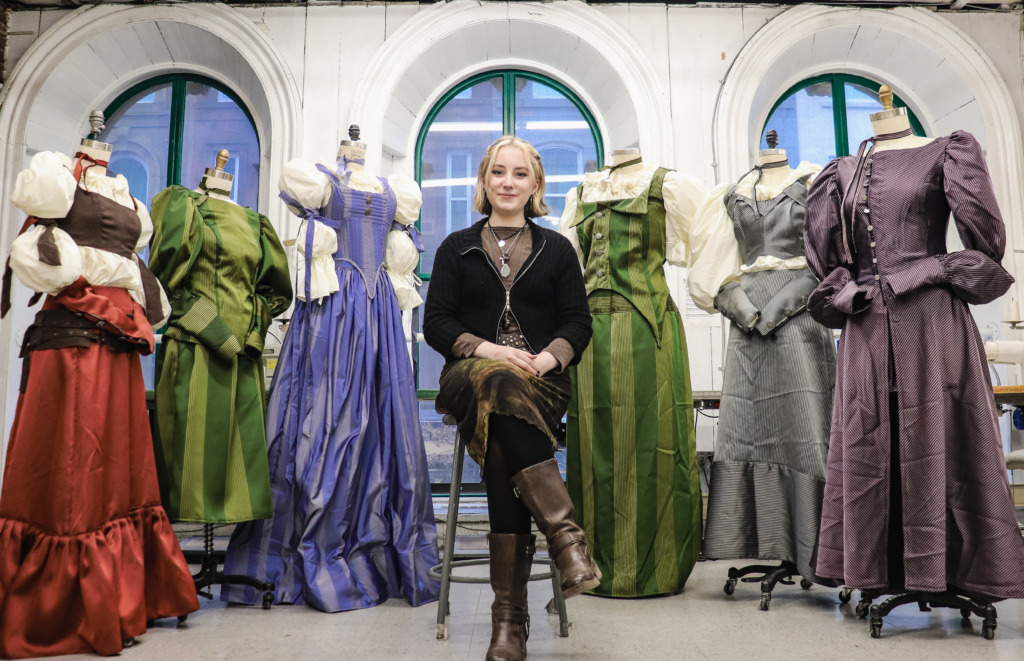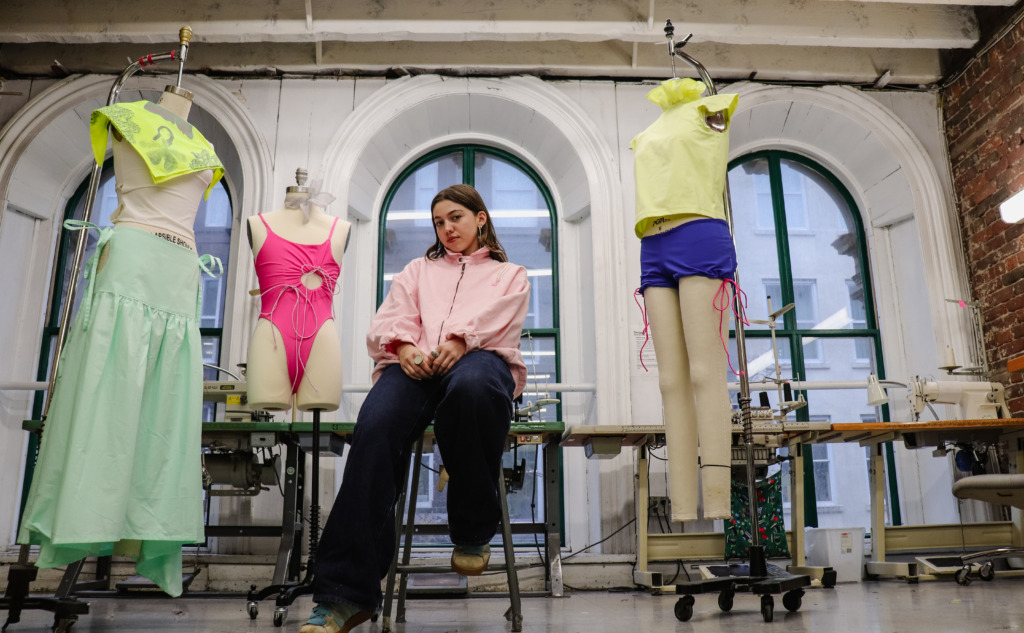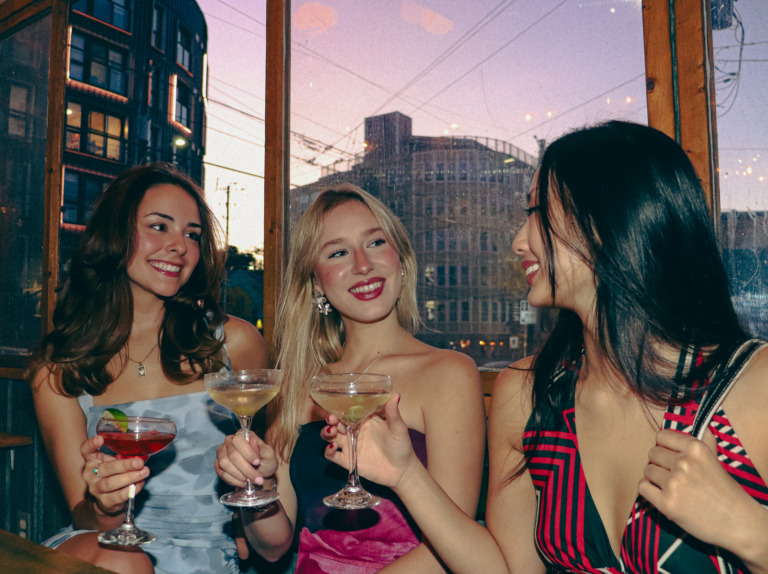
Halifax Student Designers
The Dalhousie Gazette sat down with fashion design students from NSCAD University to find out what inspires their work and how making clothes influences their own style.
The Dalhousie Gazette sat down with fashion design students from NSCAD University to find out what inspires their work and how making clothes influences their own style.
Murphy and Buckland’s responses were edited for clarity and grammar.
Mia Murphy
Mia Murphy (they/them) is a fourth-year fashion student at NSCAD University whose designs push boundaries and play with identity. Drawing on vintage workwear, 1920s scuba suits and unconventional fabrics, their pieces explore gender neutrality, bold shapes and playful disruption.

The Dalhousie Gazette: What inspires your designs?
Mia Murphy: The fall-front pants [far right] were inspired by 1920s scuba suits, and scuba wear, generally. I was looking at these metal bulbous suits, and I saw one with this really long dick tube. I was like, “Why is it so long?” and “Why is it on the outside?” I still don’t know the answers to those questions. But I took that and ran. I had a lot of fun with it.
I’m hoping to build a camo collection. I’m really inspired by workwear, utility wear, pockets, playing with gender neutrality and how that can make someone who’s non-binary feel comfortable in what they’re wearing. The blood corset was for an independent study; my roommate made the vagina dentata-inspired meets anglerfish mask [vagina dentata is Latin for toothed vagina]. It’s fully made of cardboard and painted. There’s a reading light in there.
DG: Walk us through your creative process.
MM: I do a lot of sketching, and each design changes as I go. I think about whether I want it to close in the front or on a side seam, and I spend time planning each aspect. Then I find fabrics, make samples and move to the final material. In fashion, there’s a lot of repetition — you can make a garment six times just because you’re trialling it five times. You do it over and over again. I enjoy that process quite a bit.
DG: Who or what influences your aesthetic?
MM: My experience being a trans non-binary person. I love playing with gender, breaking boxes and getting that wow factor. I do it in hopes to make other trans people feel seen in something that they’d be excited to put on their own body, and have that as an extension of their identity.
DG: How has your style evolved?
MM: I feel like I’ve improved my technique and can execute what I want more effectively. I feel like my style is through shape, I suppose. It’s about how a garment moves and expresses identity.
Emily Buckland
Emily Buckland is a fourth-year NSCAD fashion student who turns historical fashion into playful fantasy pieces. Victorian and Edwardian silhouettes meet Gothic details in designs that are whimsical, contemporary and full of texture and drama.

The Dalhousie Gazette: What inspired this collection?
Emily Buckland: I was looking at a lot of Gothic architecture and cathedrals, but also using drapery. A lot of that is just 100 per cent cotton or a cotton-poly blend. I worked at a fabric store, so I got a little bit more access to fabrics.
DG: How would you describe your designs?
EB: I really like the feminine aesthetic of Victorian and Edwardian clothes — not the values, obviously — but definitely the silhouettes. Big sleeves, full skirts, historical shapes we don’t see anymore. I focus on couture, bespoke work — things made with a lot of care, hand-sewn, using massive patterns that take tons of fabric. Not just cutting costs and making simple, small clothes.
DG: Do you design intuitively, or start with a clear plan?
EB: In my classes, they teach you to start with a mood board. You get colour, palette and texture inspiration, then start sketching. I think about what inspires me and what fabrics I have access to. A lot comes from what’s around me — especially films. I watch gothic films and fantasy TV inspired by the Victorian and Edwardian eras. There are amazing designers working on smaller films, like Colleen Atwood.
DG: How has your design style evolved since you started making clothes?
EB: Since I’m from Halifax, a lot of my stuff is inspired by nature and the ocean. My earlier work was based on pastels and the ocean, and I’ve since fully embraced a deep ocean aesthetic. I wear a lot of black. My aesthetic is darker, more jewel-toned. Everything I make now is darker and fantasy-related.
DG: How has studying fashion changed how you think about clothing?EB: I have such high respect for people who make clothing. You don’t really realize that every single piece of clothing is made by someone. Learning how to construct garments made me appreciate how much work goes into it. I do a lot of thrifting, and now I look at clothes differently — like, “This one’s cotton, I can dye it,” or “This one’s silk, turn down the iron heat.” It’s kind of niche knowledge, but I love it.

Cybelle LeBlanc is a fashion student at NSCAD University, creating playful, avant-garde designs that celebrate individuality. Her pieces mix soft, botanical-inspired colour palettes with bold, vibrant contrasts, using natural and recycled fabrics to craft clothing that is fun, expressive and empowering.
The Dalhousie Gazette: What inspired your pieces or collection?
Cybelle LeBlanc: I grew up a contemporary dancer, and all my pieces use stretch, which is what a lot of dancers wear. I’m really interested in floral, botanical, but also very avant-garde and playful, yet a little sexy and fun.
DG: What materials did you use, and why?
CL: I used cotton — it’s a very simple fabric to sew with, and it’s pretty cheap. I also used silk organza, which is natural from silkworms. I actually dyed it naturally, which is more ethical. I dyed it with lupin flowers and cochineal, which is a bug used for natural dye. I also used spandex stretch, which is for that kind of ‘dancerly’ look.
DG: Do your designs reflect your own personal style, and how has your dance background influenced them?
CL: I wouldn’t say the dance part is what I base everything off of, but I grew up wearing stuff that makes you feel really good. Fashion and personal style are supposed to celebrate your body and make you feel confident. Fashion is taken super seriously, or everyone tries to look the same, but we should bridge that gap — be playful, have fun, and celebrate your body with a more individualistic style. I love very soft colours, like pinks and light blues, but I also love pairing them with vibrant neons for contrast, mixing baggier pieces with super tight bodysuits.
DG: Has creating your designs influenced your own personal style?
CL: Every day I want to feel powerful, magical and confident in what I’m wearing. Fashion and making clothes, since I started going to school for fashion, have made me feel more powerful and confident. Just being able to make some sort of product that could make someone feel that way. I think that’s how it kind of bounces back and forth. That’s how it inspires my personal style. The clothes I make are the epitome of my personal style. They’re bright and colourful.

Jessie Mosh is a fashion student at NSCAD University, reimagining women’s skatewear. Her designs blend industrial hardware, graffiti-inspired graphics and utilitarian silhouettes to create pieces that are functional, bold and built for movement.
The Dalhousie Gazette: What inspired your pieces or collection?
Jessie Mosh: I’m working on a clothing brand right now. It’s called MOSH: it’s my last name. It’s a women’s skatewear brand. It’s been my plan for ages now, since before I came to NSCAD, but I came to the fashion program so I could build skills to do that. All four of these pieces were made for my brand. They’re all intended for women’s skateboard wear.
DG: How would you describe your design aesthetic?
JM: Military, industrial, graffiti vibes. Very utilitarian stuff. I love having a bunch of grommets, zippers and pockets — I like all that stuff. I feel like that’s the kind of energy it’s giving.
DG: What message does your brand carry?
JM: The goal is to create pieces that women feel comfortable skating in, making sure they fit in the right spots while also giving the freedom to move. While at the same time, having dope designs to make you feel confident to get out there and just be yourself.
DG: Does this come from your own experience skating?
JM: It does, yeah. The reason I got so hyper-fixated on this is because there are literally no other brands doing this right now. It’s all men. The entire skate team, everywhere — it’s just freaking men. I’ve skated in a bunch of places around the world. Toronto, Halifax, all over. And there’s just no skate clothes meant for girls. You can’t just go to the store and buy something that fits you. You have to buy a pair of super massive jeans and belt them.
DG: Walk us through your creative process. Do you design intuitively, or do you go in with a plan?
JM: It definitely depends on whether it’s for class or not. Lately, I really only have time to do things for class. I try my best to make class assignments correlate with what I want to do. For example, for a skirt assignment, I wanted to figure out how I could make it work for my brand — I planned a skort for the mock-up, but didn’t have time to finish it. I start with a sketch. I have collections of images I find inspiring, pick one, make a sketch, and then see where it goes. If it changes throughout the process, that’s fine.
DG: How do your designs reflect your personal style?
JM: Honestly, it’s just the stuff that I want to wear to skate. The things that I can’t find in the store that I wish I could wear, I want to provide for everybody else.






